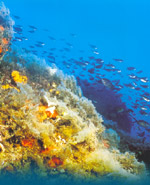|
|
|
|
|
|
| |
|
Situated
North of Africa, Tunisia has a surface of 164.000 Km2.
Its bio-geographical biodiversity is distinguished by the cohabitation
of very diversified and contradictory landscapes.
In
fact, on some hundreds of km, the visitor goes from the Sahara
desert to a mountain landscape, covered with green and forests,
where the most common trees are Zen and Cork oak. |
|
|
| |
The
sea-line is 1300km long on the Mediterranean, which gives him
one of the most important marine openings in relation with its
surface in Africa.
Tunisia
has seven different major eco systems. 8 national parks and
around 20 nature reserves are in relation with these. The eco
systems are coastal, isle, humid, mountainous, steppe and desert
or oases savannas. |
|
|
| |
|
|
|
The
Tunisian coast shows a great diversity of fauna and flora because
related to the great diversity of the existing landscapes.
It evolutes distinctively from north to south, going from rocky
cliffs in the north to the muddy waters and the shallows of
the continental southern platform, like the muddy waters from
the bay of Gabes which give a shelter to something like half
the hibernating birds of the Mediterranean, somewhere around
350.000 individuals. |
|
|
| |
|
|
Is composed by 8 major archipelagos, which hug the coast
plus a multitude of small isles and islets. Together,
they constitute a accumulation of specific housings, where
it is not exceptional to find endemic species of fauna
and flora.
|
|
|
|
|
|
|
|
|
|
|
|
|
|
|
|
|
| |
The
most representative isles are those which form the archipelago
of the national park of the isles Zembra and Zembretta,
which gather each summer something like 90.000 Cory's
Shearwater (Calonectris diomedea). These birds coming
from South Africa nest here in the summer. And constitute
the most important colony of eastern Mediterranean. |
|
|
|
|
| |
|
|
In
Tunisia, the humid zones cover a surface of approximately 1.000.000
hectares distributed among others, between the seven big marine
or coastal lakes and something like 30 salted continental lakes
(sebkhas and chotts).
humid zones are used by various migrating birds coming from
Europe and Asia.. One encounters here an impressive lot of water
birds and other animal species (reptiles, amphibians, fish and
invertebrates).
The
national park of Ichkeul, which represents this ecosystem, is
a unique site because of its variation of salinity and its capacity
of reception of migrating birds. Their number for certain species
is 7 times the amount of the western Mediterranean. |
|
|
| |
|
|
| The
5 major mountainous systems of Tunisia group the majority
of forests and endemic plants of the country. |
|
|
This system presents known bioclimatic differences, from
North to South, from the sub humid floor to the semi dry
floor. As fauna and flora are subjects to climatic changes
they are much diversified. One encounters there several
specific species like the mountain gazelle and the striped
hyena, characteristics of the Chaambi national park. |
|
|
|
|
| |
|
|
|
|
The
steppe area covers important surfaces in the center of
the country, they are the intermediates between the forests
of the mountainous areas and the desert in the south.
The
high steppes are characterized by the presence of important
layer of Alfa grass. The low steppes distinguish themselves
by the presence of a remainder of savanna covered by acacia
raddiana and are include several salted lakes here and
there on their surface. |
|
This
was squatted before by a fauna of savanna, and remainders
of it are still present, like you can see in the national
park of Bouhedma, The addax antelope, the Oryx antelope,
the dorcas gazelle, the Mohr gazelle, the ostrich and
other pre desert species, representatives of the savanna.
One
must be aware that the former Tunisian savanna sheltered
several big herds of elephants. Hannibal did use them
to his advantage in the Punic war. |
|
|
|
|
|
|
|
|
|
|
|
|
|
| |
|
|
The
south of Tunisia is the center of a magnificent Saharan
desert of two types.. One is sandy and constituted by
the Grand Eastern Erg; the other one is rocky and is situated
in the regions of Jeffara, Dahars and Ouara.
The Saharan desert shelters different forms of animal
and vegetal life specific and endemic to North Africa.
The national park of Sidi Toui and Jebil represent this
ecosystem very well. |
|
|
|
|
|
| More,
this desert on the level of the mountains of Tabaga of
Medenine has a unique outcrop of the "marine permien
of Africa" This a unique geological phenomenon. |
|
|
|
|
|
| |
|
|
| |
|
|
Spread
out in the desert areas, the oases represent more than
75.000 ha. Unless the intensification of agricultural
activities, exceptional vegetation and some mammals, more
or less accustomed to human activity can be found.
The oases, with their exuberant vegetation are a rest
and food area for the migrating birds which cross the
desert. |
|
|
|
|

